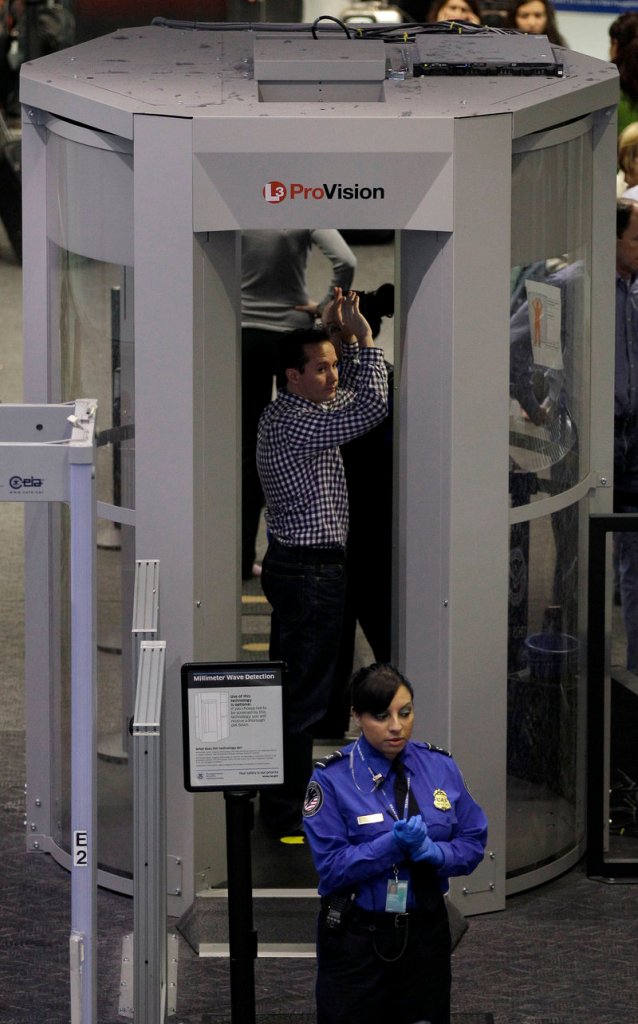PORTLAND – The latest generation of sophisticated weapon detectors is coming to the Portland International Jetport.
In the coming months, the Transportation Security Administration will begin installing three “advanced imaging technology” scanners at the airport’s new security screening checkpoint.
The machines bounce electromagnetic waves off passengers and create images that can show potentially threatening metal or plastic objects. The scanners will also use new software that the TSA says should ease passenger privacy concerns.
Previous body scanners at other airports have displayed passengers’ bodies with too much anatomical detail for some critics, while the new ones being installed in Portland show each passenger as a generic gingerbread man-like cutout figure.
“It’s the best available technology in the world, designed to detect metallic and non-metallic threats, such as plastic explosives,” said Ann Davis, a TSA spokesperson in Boston. “The equipment screens passengers safely and efficiently without physical contact.”
The TSA has deployed some 510 of the scanners at 92 of the nation’s roughly 450 commercial airports since 2007, and plans to install another 500 at U.S. airports, including Portland, in 2012.
Though not every airport will get the scanners, Davis said Portland will receive them in the next few months. She declined to provide an exact timetable.
The TSA will pay for the scanners, which cost $130,000 to $170,000 each.
The scanners will supplement existing metal detectors at the airport’s new security screening checkpoint, which has been in use since the airport’s $75 million, 145,000-square-foot terminal opened in early October.
The 9,950-square-foot, five-lane checkpoint, which has an additional 17,000 square feet of queue space, replaced the airport’s old 2,300-square-foot security checkpoint.
Airport Director Paul Bradbury said all of the airport’s security scanning equipment is new, having been upgraded as part of the expansion. The new security checkpoint opened roughly 10 years after 9/11 terrorists Mohamed Atta and Abdulaziz Alomari cleared security in Portland and subsequently crashed American Airlines Flight 11 into the World Trade Center.
Davis said the new scanners take “a few seconds longer” than traditional metal detectors, but said security wait times will not increase because passengers must still wait while their carry-on luggage is screened.
Earlier advanced imaging scanners created black-and-white images of individual passengers, which led to widespread concerns over passenger privacy. The sensitive nature of the images required that they be viewed by TSA agents in remote “viewing rooms” away from the security checkpoint.
Davis said the new scanners use Automated Target Recognition software, which creates the generic image of the human body, and software flags suspicious objects with a yellow box.
The changes should allay privacy concerns and allow agents to view images at the security checkpoint, instead of in private rooms.
Travelers at the airport this week welcomed the new equipment. Security, not privacy, was their top concern.
“Anything that can improve security should be done. I don’t see how someone can complain,” said LaGuardia-bound flyer Ed Fenwick as he approached the security line Wednesday.
“It’s not that big a deal. Security is more important,” said Matthew Clines, who was headed to Texas. Clines added that the new checkpoint looked more orderly than the old set-up, where the line used to wrap around the building.
Because privacy concerns persist, Davis, the TSA spokeswoman, said passengers may choose to be patted down by TSA agents instead of being screened by the scanners.
Bradbury, the airport director, said the airport anticipated the scanners and worked with the TSA to make sure they arrived after the new terminal opened. The airport also altered its design plans to ensure the checkpoint could accommodate the larger equipment.
Bradbury said the ceiling of the screening area, which was intentionally kept low to mitigate the clatter of luggage and machinery, was raised about a foot.
“We did a change mid-design to raise the (ceiling) of the checkpoint,” Bradbury said.
Davis said Portland’s planning allowed the airport to avoid costly alterations.
“Knowing that the new terminal was coming, they designed a checkpoint that can accommodate” the scanners, Davis said. “Airports with existing checkpoints have had to be reconfigured. Walls have had to be moved.”
Jonathan Hemmerdinger can be reached at 791-6316 or:
jhemmerdinger@mainetoday.com
Send questions/comments to the editors.




